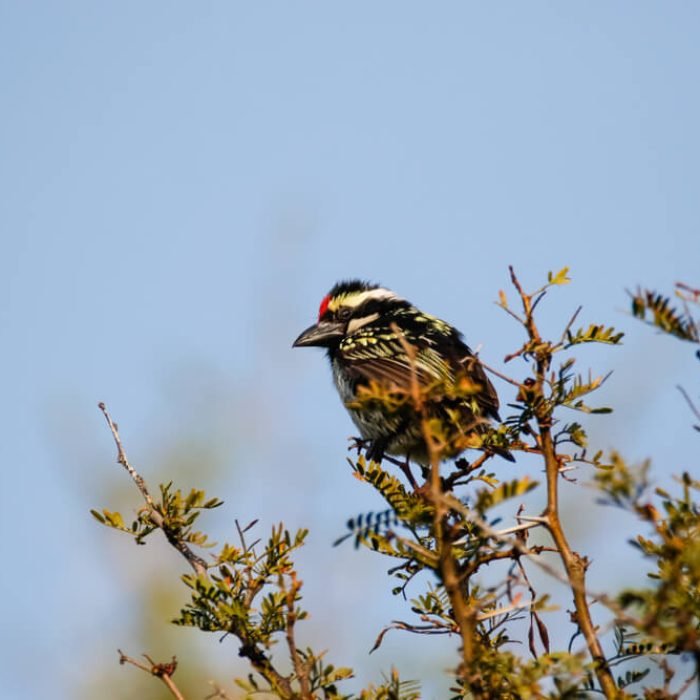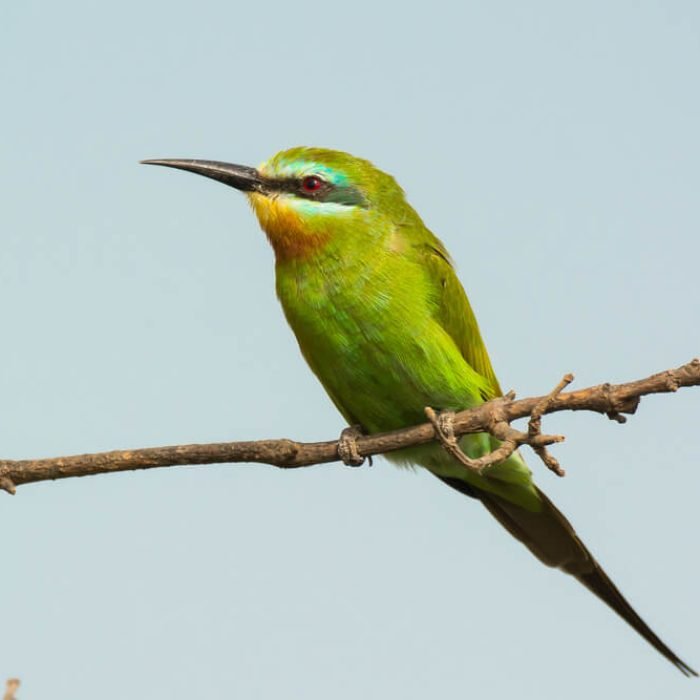Northern carmine bee-eater
- Merops nubicus
- IUCN Status: Least Concern
- Trend: decreasing

General Information
The northern carmine bee-eater (Merops nubicus) is a brightly-coloured bird in the bee-eater family, Meropidae.
It is found across northern tropical Africa, from Senegal eastwards to Somalia, Ethiopia and Kenya.
Description
This species, like other bee-eaters, is a richly colored, slender bird, predominantly carmine in color, except for a greenish blue head and throat and distinctive black mask. This species has red eyes, a black, pointed, decurved beak, and elongated central tail feathers.
The sexes are similar in appearance, and the juveniles can be distinguished from adults by their lack of elongated central tail feathers and the pinkish brown coloration of their mantle, chest to belly, and flanks.
The call is a deep, throaty tunk in flight; a series of rik notes when perched.
Fun Facts
The northern carmine bee-eater differs from the southern carmine bee-eater which has a carmine coloured throat rather than the blue throat of the northern species.
Diet
Their diet is made up primarily of bees and other flying insects, such as flying ants, grasshoppers and locusts. The main hunting strategy of bee-eaters is to keep watch for flying insects from a perch, and then snatch them out of the air using their beaks, before returning to the perch.
Reproduction
They nest in large colonies in cliffs, usually near river banks, where they use their bills to dig long horizontal nesting tunnels, often eight feet or more in length. Some colonies may consist of just a few nests while others accommodate hundreds of breeding birds. The same site may be used for several years and then the colony may all move to another location. Occupied nests accumulate a black litter of insect remains and smell strongly of ammonia. Three to five eggs are laid per clutch.
Conservation
It is listed by the International Union for Conservation of Nature (IUCN) as, “Least Concern”.
Distribution and Habitat
It is native to Benin, Burkina Faso, Cameroon, the Central African Republic, Chad, the Democratic Republic of the Congo, Côte d’Ivoire, Eritrea, Ethiopia, Gambia, Ghana, Guinea, Guinea-Bissau, Kenya, Liberia, Mali, Mauritania, Niger, Nigeria, Senegal, Sierra Leone, Somalia, Sudan, Tanzania, Togo and Uganda. It occurs as a vagrant in Burundi.
References
Share:
- Kingdom: Animalia
- Phylum: Chordata
- Class: Aves
- Order: Coraciiformes
- Family: Meropidae
- Genus: Merops















